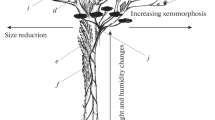Abstract
Studies of the Adjarian flora resulted in a detailed classification of the ergasiophygophytes, based mainly on the degree of their naturalization: (1) The ephemeroergasiophygophytes display unstable naturalization both in artificial and natural habitats, and disappear after only a few growing seasons. (2) The deuteroergasiophygophtes show stable naturalization in anthropogenic habitats. (3) The protoergasiophygophytes are distinguished by uncertain stability of naturalization in natural habitats, and, if firmly naturalized on a certain spot, they lack any tendency to further spreading. (4) The autergasiophygophytes tend to spread in natural habitats. (5) The aggressive ergasiophygophytes transform natural vegetation in new plant communities, and can become dominant species in these communities. New terms, viz. emphemeroxenophytes, protoneophytes, non-aggressive neophytes, slightly aggressive neophytes, and postneophytes with vegetative reproduction have also been introduced to express diverse features of the xenophytes.
Similar content being viewed by others
Literature Cited
Davitadze, S. (in press): Vostočnoaziatskije elementy v alochtonnoj flore Adžarii.—Izvěst. Batums. Bot. Sada, Tbilisi.
Dmitrijeva, A. A. (1967): K voprosu o zanosnych i dičajuščich rastěnijach Batumskogo poberež'ja.—Izvěst. Batum. Bot. Sada, Tbilisi, 14: 58–65.
Džavachišvili, I. (1930): Sakartvelos ekonomiuri istoria, 1.—Tbilisi.
Faliński, J. B. (1969): Neofity i neofityzm. Diskusje fitosocjologiczne (5).—Ekol. Polska, Ser. B, Warszawa, 15: 337–355.
Grossgejm, A. A. (1915): Zamětki o flore Kolchidy.—Věst. Tifl. Bot. Sada, Tbilisi, 11/2: 84–87.
Grossgejm, A. A. (1934): Flora Kavkaza, 4, ed. 1.—Baku.
Grossgejm, A. A. (1939): Flora Kavkaza, 1, ed. 2.—Baku.
Grossgejm, A. A. (1939): O raspostraněnii po Kavkazu subtropičeskich odnodolnych prišelcev—sornjakov.—Baku.
Grossgejm, A. A. (1940): Flora Kavkaza, 2, ed. 2.—Baku.
Grossgejm, A. A. (1945): Flora Kavkaza, 3, ed. 2.—Baku.
Grossgejm, A. A. etMakašvili, A. K. (1929): K voprosu o proischožděnii, sostave i charaktere sornoj rastitěl'nosti čajnych plantacij Zapadnoj Gruzii i Adžaristana.—Trudy po Priklad. Bot., Genet. i Selekc., Leningrad, 22/4: 43–96.
Holub, J. etJirásek, V. (1967): Zur Vereinheitlichung der Terminologie in der Phytogeographie.— Folia Geobot. Phytotax., Praha, 2: 69–113.
Holub, J. etJirásek, V. (1971): Slovníček fytogeografických termínů.—Preslia, Praha 43: 69–87.
Kolakovskij, A. A. etSachokija, M. F. (1946): Novyje dannyje k adventivnoj flore Černomorskogo poberež'ja Kavkaza.—Soobšč. AN GSSR, Tbilisi, 7/3: 139–143.
Makašvili, A. K. (1936): Zanosnyje sornyje rastěnija vlažnych subtropikov SSSR.—In:Gajdamakin, V. I., Makašvili, A. K., Jabrova, V. S., etJarošenko, P. D.: Sornyje rastěnija vlažnych subtropikov SSSR i měry bor'by s nimi. p. 90–102 et fig. 15–26.—Suchumi.
Makašvili, A. K. (1943): Novyje dannyje k adventivnoj flore Kavkaza.—Soobšč. AN GSSR, Tbilisi, 4/8: 809–817.
Mandžavidze, D. V., Cicvidze, A. T., Matinjan, A. B., Morozova, T. A., Tatišvili, G. S. etTatarišvili, A. N. (1968): Derev'ja i kustarniki Batumskogo botaničeskogo sada.—Tbilisi.
Mayr, H. (1925): Waldbau auf naturgeschichtlicher Grundlage.—Berlin.
Ponert, J. (1973): 60 let Batumské botanické zahrady.—Zahrádkář, Praha, 5: 277.
Rikli, M. (1903): Die Anthropochoren und der Formenkreis desNasturtium palustre DC.— Achter Bericht der zürcherischen botanischen Gesellschaft 1901–1903, p. 71–82.— Ber. Schweiz. Bot. Ges., Bern, 13.
Šavrov, N. N. (1910): Dva slučaja odičanija tropičeskich rastěnij v Kutaisskoj gubernii— Izvěst. Kavk. Otd. Imper. Rus. Geogr. Obšč., Tbilisi, 20/1 14–17.
Šuĺgina, V. V. (1954):Spiraea.—In: Derev'ja i kustarniki SSSR, Moskva et Leningrad, 3: 269–332.
Thellung, A. (1905): Einteilung der Ruderal-und Adventivflora in genetische Gruppen.— In:Naegeli, O. etThellung, A.: Die Flora des Kantons Zürich. 1. Teil: Die Ruderal und Adventiv Flora des Kantons Zürich.— Vierteljahrschrift Naturforsch. Ges. Zürich, 50: 232–236.
Thellung, A. (1915): Pflanzenwanderungen unter dem Einfluss des Menschen.—Englers Bot. Jahr., Beiblatt, Leipzig, 53, 116: 37–68.
Voronov, Ju. N. (1916): O zanosnych rastěnijach Kavkazskoj flory.—Izvěst. Kavk. Muz., Tbilisi, 10/1: 96–100.
Author information
Authors and Affiliations
Rights and permissions
About this article
Cite this article
Ponert, J. Ergasiophygophytes and xenophytes of East Asiatic origin in Adjaria a stimulus to new terminology, especially for ergasiophygophytes. Folia geobot. phytotax. 12, 9–22 (1977). https://doi.org/10.1007/BF02854506
Received:
Issue Date:
DOI: https://doi.org/10.1007/BF02854506



